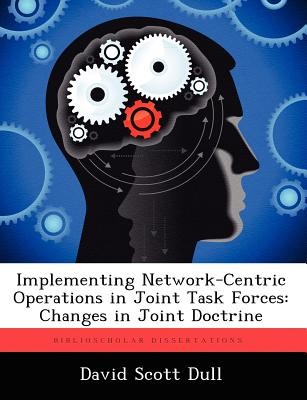
- We will send in 10–14 business days.
- Author: David Scott Dull
- Publisher: BiblioScholar
- ISBN-10: 1249368146
- ISBN-13: 9781249368144
- Format: 18.9 x 24.6 x 0.6 cm, softcover
- Language: English
- SAVE -10% with code: EXTRA
Implementing Network-Centric Operations in Joint Task Forces (e-book) (used book) | bookbook.eu
Reviews
Description
This thesis examines joint publications and the emerging concept of Network-Centric Operations (NCO) as a basis for identifying recommended changes to doctrine in order to implement NCO in joint task forces (JTFs). Technology is allowing the United States military to evolve from the industrial age to the information age. The Office of the Secretary of Defense has termed this evolution "Force Transformation" and identified Network-Centric Operations as the primary concept encompassing the future capabilities of the joint force. The Department of Defense calls for co-evolution of the doctrine, organization, and technology of NCO. The technology required to achieve NCO continues to rapidly expand, and individual military services have started procuring and implementing the technology as it becomes available. Subsequently, US military JTFs have already attempted to realize the benefits of NCO in operations such as Operation Enduring Freedom and Operation Iraqi Freedom, yet the military continues to organize JTFs according to Department of Defense planning guidance and doctrine that date to July of 2001. The conclusions reached in this thesis are that size, structure, interdependence, and synchronization are key NCO organizational attributes dictating shifts in basic joint doctrine and JTF organizational architecture.
EXTRA 10 % discount with code: EXTRA
The promotion ends in 16d.10:52:21
The discount code is valid when purchasing from 10 €. Discounts do not stack.
- Author: David Scott Dull
- Publisher: BiblioScholar
- ISBN-10: 1249368146
- ISBN-13: 9781249368144
- Format: 18.9 x 24.6 x 0.6 cm, softcover
- Language: English English
This thesis examines joint publications and the emerging concept of Network-Centric Operations (NCO) as a basis for identifying recommended changes to doctrine in order to implement NCO in joint task forces (JTFs). Technology is allowing the United States military to evolve from the industrial age to the information age. The Office of the Secretary of Defense has termed this evolution "Force Transformation" and identified Network-Centric Operations as the primary concept encompassing the future capabilities of the joint force. The Department of Defense calls for co-evolution of the doctrine, organization, and technology of NCO. The technology required to achieve NCO continues to rapidly expand, and individual military services have started procuring and implementing the technology as it becomes available. Subsequently, US military JTFs have already attempted to realize the benefits of NCO in operations such as Operation Enduring Freedom and Operation Iraqi Freedom, yet the military continues to organize JTFs according to Department of Defense planning guidance and doctrine that date to July of 2001. The conclusions reached in this thesis are that size, structure, interdependence, and synchronization are key NCO organizational attributes dictating shifts in basic joint doctrine and JTF organizational architecture.


Reviews